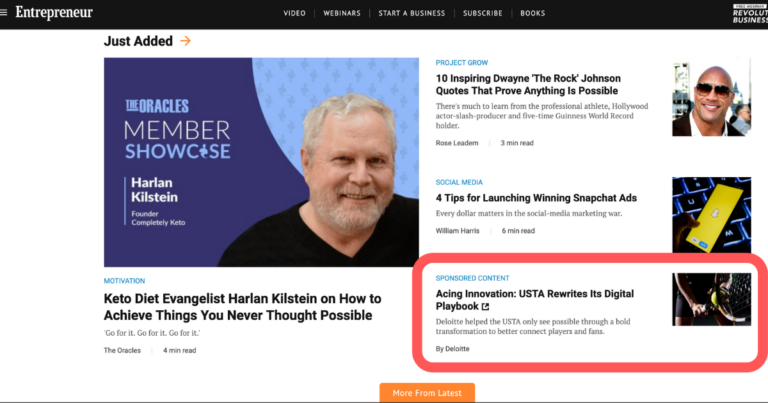There are a lot of digital marketing methodologies to stay on top of, but native is an important one to understand. Learn all about it with our Guide to Native Advertising.
Native advertising falls within the giant realm of content marketing.
This kind of advertising must be: paid for, native to the publisher’s platform (blends in), and labeled as an advertisement. It’s legally required to disclose that it’s an ad.
What is Native Advertising?
Native advertising, whether long-form articles, short tweets, or a stylized Instagram featuring a product, is always paid. This is why it is defined in the category of paid media. Businesses and content marketers use it as common practice.
Native advertising is another avenue for brands to publish content and inform or engage with their audience. While it falls under content marketing, it’s not a catch-all term for branded content online. Native ads are different than display or social ads.
This type of native content needs to be contextually relevant and and make sense. It fits within a normal feed and doesn’t jar or disrupt the audience’s experience.
Guide to Native Advertising
Social media sites like Facebook, Instagram, and Twitter make money off allowing businesses to put in their native advertising within a user’s feed. In fact, native ads will make up more than half of all display spending in 2017.
Besides the “in-feed” ads that you’ll find on social media, there are also promoted listings within searches that are also considered native ads.
Native advertising includes (but isn’t limited to) sponsored content, paid content, and advertorials.
What does a Native Ad look like?
Since native advertising fits within a variety of online platforms, the look and feel of it can differ greatly.
Some common examples of native ads could look like:
- Educational content
- Imagery or video only content
- How-to content
- Quizzes
Think entertaining or helpful. It has a purpose to the audience and value to them.
While it’s still a form of advertising, it doesn’t evoke the pushy approach. Unlike traditional tv or print ads, native advertising isn’t screaming sales-y. A native ad is usually not going to resemble a traditional ad that’s all about touting the benefits of a product or service and persuading the audience to buy. The purpose isn’t to mislead customers. It’s to engage with them in a way that is comfortable and familiar to them.
A native ad is not as much about the brand itself necessarily but about positioning the brand as an expert or leader within its industry.
Native ads are usually highly targeted at what the brand understands their ideal audience to be. Who would be most interested in the brand? What has been the overwhelming demographic in past customers? The brand figures this out by analyzing data and doing their research – or they hire a marketing team to help out with all of this.
Examples of native ads include those aesthetically pleasing promoted Instagram posts from brands or clever promoted tweets which pop up seamlessly in a user’s timeline.
What is Sponsored Content?
Sponsored content is a specific type of native advertising where businesses pay publishers or influencers to post about their brand. This could be a celebrity promoting a vitamin, clothing line, or app. It could be a list on BuzzFeed that focuses on a certain brand.
Taking a look at sponsored Instagram posts:
- Influencers charge $271, on average, to share a sponsored post on Instagram.
- The average follower count of an influencer is almost 63,000 people.
- The most popular category for paid content is lifestyle.
An Instagram influencer doesn’t necessarily have millions of followers. Moreover, the above statistics differ greatly based upon what industry the business sponsoring is in.
Why use a native ad over other forms of digital ads?
People are much more likely to share a brand’s native advertising on their personal social pages when it fits within the type of content to which they already enjoy subscribing and sharing.
Native advertising also results in more time spent from consumers with the content than a typical ad.
Twitter, Facebook, and Instagram have all integrated native advertising into their sites. This type of content marketing has been wildly successful for both the social media corporations and the businesses advertising on them.
How do you determine the success of a native ad?
Some metrics used to measure the success of native ads include:
- Clickthroughs
- Social shares
- Downloads
- Views
With ad blockers and constantly updating feeds, it’s hard to get consumers to pay attention to brands in such a busy online world. Native advertising engages an audience on their terms and can inspire not only brand awareness but brand loyalty.
We hope you’ve learned from our Guide to Native Advertising! Now take the next step by getting our Free Website Audit!


